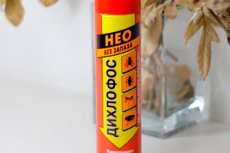Medical expert of the article
New publications
Dichlofos vapor poisoning
Last reviewed: 29.06.2025

All iLive content is medically reviewed or fact checked to ensure as much factual accuracy as possible.
We have strict sourcing guidelines and only link to reputable media sites, academic research institutions and, whenever possible, medically peer reviewed studies. Note that the numbers in parentheses ([1], [2], etc.) are clickable links to these studies.
If you feel that any of our content is inaccurate, out-of-date, or otherwise questionable, please select it and press Ctrl + Enter.

Dichlofos is a chemical preparation designed to kill insects in residential and industrial premises. Initially, the insecticide included dangerous toxins, which caused many cases of intoxication. Today, its composition has changed, the new formula uses pyrethroids, which makes dichlofos less dangerous.
Causes of the dichlorvos poisoning
Intoxication by a chemical substance is possible by ingestion, skin contact, and inhalation of vapors. The main causes of damage to the body:
- Use indoors without ventilation.
- Work without special protective uniforms.
- Intentional use of the drug for the purpose of suicide/murder.
- No persons were evacuated from the premises at the time of treatment.
According to its toxicity, dichlofos has the third class of hazard. On this basis, poisoning most often occurs when working with the drug incorrectly. The lethal dose of the chemical is 0.5-2 g.
Symptoms of the dichlorvos poisoning
The clinical symptomatology of the lesion depends on how the insecticide entered the body. If vapors are inhaled, the following symptoms develop:
- Headache and dizziness.
- Runny nose, cough.
- Respiratory irritation.
- Elevated body temperature of 38-39 °C.
- Movement disorder.
- Nausea and incessant vomiting.
If dichlofos gets on the skin, there are signs of allergic reaction: itching, burning, redness, swelling, pain. If the substance gets on the mucous membrane of the eyes, increased lacrimation, conjunctival discharge, itching and pain develop.
If ingested, the chemical causes the most severe symptoms: excruciating vomiting, excessive sweating, respiratory distress, seizures, diarrhea, and decreased visual acuity.
If poisoning by dichlorvos is exposed to a pregnant woman at an early stage, it can cause a miscarriage. In later periods, there is a risk of abnormalities in the unborn child and fetal death.
Stages
Also, intoxication with insecticide has several stages, each with its own symptomatology:
- Increased agitation - develops a few minutes after exposure to the chemical. The person starts thrashing around, movement coordination is impaired. Blood pressure rises, pupils constrict, migraine, increased salivation and tachycardia.
- Coordination disorder - occurs after a few hours. The patient's condition deteriorates rapidly, urges to the toilet become more frequent (defecation and urination are painful). It is hard to breathe, vision becomes blurred, cramps and tremors appear, saliva flows. Stupor develops. Without emergency medical attention, there is a risk of pulmonary edema and death.
- Paralytic stage - the victim loses consciousness, respiratory and muscular reflexes are disturbed. Blood pressure drops sharply and bradycardia develops. Without medical assistance, death occurs within 12-24 hours.
Complications and consequences
If left untreated, the problem can lead to complications and distant effects. The latter develop immediately after exposure to the chemical. Complications become apparent after a certain time and depend on the amount of toxin received.
The most common complications result in these conditions:
- Toxic hepatitis
- Nephropathy
- Pneumonia
- Dystrophy of the heart muscle and others.
Long-term effects are evident for up to 3 years after the event:
- Polyneuritis and other lesions of the peripheral nervous system.
- Disturbance of the functioning of the autonomic system.
- Dysfunctions in the functioning of internal organs.
- Inflammation of the spinal cord and spinal roots.
Treatment of the dichlorvos poisoning
When poisoned by dichlorvos, proper first aid is very important:
- If the substance gets into the eyes, they should be rinsed with 2% soda solution, saline solution or under running water. If after rinsing the mucosa is reddened, it is recommended to pump anti-inflammatory drops, apply a bandage and consult an ophthalmologist.
- If the chemical got on the skin, the tissues are treated with a solution of 2% baking soda or washed with soap. It is forbidden to rub the lesion, as mechanical impact promotes deeper penetration of toxins.
- In case of inhalation intoxication, the person should be taken out to fresh air, rinse the nostrils and mouth with water. It is also necessary to remove from the victim all clothing that has been in contact with the insecticide, as it may have a poisoning effect.
- If the substance is ingested, the patient should be given plenty of water, vomiting and a sorbent. After 40-60 minutes, the victim is given a saline laxative, given an enema and plenty of water. It is also necessary to observe bed rest.
All first aid measures are aimed at removing toxins from the body and alleviating the condition of the victim. Mild poisonings do not require medical intervention and pass within 3-4 days. In severe forms of intoxication, professional medical assistance is required.

